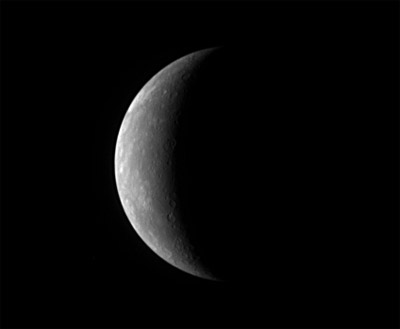 On January 14, NASA’s MESSENGER spacecraft flies past Mercury. MESSENGER — short for MErcury Surface, Space ENvironment, GEochemistry, and Ranging — will be making the first close-up observations of the innermost planet in 33 years. This flyby marks the first of three encounters with the planet, providing gravity assists necessary to place the probe in orbit around Mercury in March 2011.
On January 14, NASA’s MESSENGER spacecraft flies past Mercury. MESSENGER — short for MErcury Surface, Space ENvironment, GEochemistry, and Ranging — will be making the first close-up observations of the innermost planet in 33 years. This flyby marks the first of three encounters with the planet, providing gravity assists necessary to place the probe in orbit around Mercury in March 2011.
January 14, 2008
This afternoon, NASA’s MESSENGER spacecraft will skim just 125 miles (200 km) above Mercury’s equator at a speed of 16,000 mph (26,000 km/h). The spacecraft — on a mission that began August 3, 2004, with launch from Cape Canaveral — has traveled 2.23 billion miles (3.59 billion km) to reach Mercury. On the way, it flew past Earth once (August 2005) and Venus twice (October 2006 and June 2007).
MESSENGER started observing Mercury yesterday morning with its full suite of instruments. From then until tomorrow, it will take 1,300 images of the planet and study its surface, interior, magnetic field, and thin atmosphere. Closest approach comes at 2:05 P.M. EST today.
This is the first close-up reconnaissance of Mercury since 1975, when the Mariner 10 spacecraft made its third and final flyby. Due to a quirk of Mariner 10’s trajectory, the craft saw the same hemisphere of the planet at each encounter. So, scientists have seen detail on only 45 percent of the planet’s surface. This leaves Mercury with the largest area of terra incognita in the solar system.
During this encounter, MESSENGER will view approximately half of the previously unexplored terrain. The spacecraft will also measure the planet’s surface composition, map its topography, analyze the magnetic field, and explore the ultrathin atmosphere.
The flyby occurs over Mercury’s equator, providing scientists a perspective they won’t get during the orbital mission. Once in orbit in 2011, MESSENGER will fly close to the planet’s poles but far from the equator. So, this and the two subsequent flybys will offer the best views we’ll get of the equatorial regions.
The spacecraft will start returning its precious data 22 hours after closest approach, and will take about a week to download it all. Check back with us frequently, as I’ll be keeping you up-to-date with the latest news from Mercury throughout the coming days and weeks.